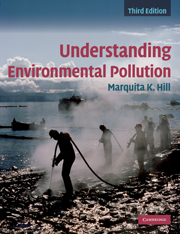Book contents
- Frontmatter
- Contents
- Preface
- Acknowledgements
- List of abbreviations and acronyms
- 1 Understanding pollution
- 2 Reducing risk, reducing pollution
- 3 Chemical toxicity
- 4 Chemical exposures and risk assessment
- 5 Air pollution
- 6 Acid deposition
- 7 Global climate change
- 8 Stratospheric ozone depletion
- 9 Water pollution
- 10 Drinking-water pollution
- 11 Solid waste
- 12 Hazardous waste
- 13 Energy
- 14 Persistent, bioaccumulative, and toxic
- 15 Metals
- 16 Pesticides
- 17 Pollution at home
- 18 Zero waste, zero emissions
- 19 Chemistry: some basic concepts
- Index
- References
11 - Solid waste
Published online by Cambridge University Press: 05 June 2012
- Frontmatter
- Contents
- Preface
- Acknowledgements
- List of abbreviations and acronyms
- 1 Understanding pollution
- 2 Reducing risk, reducing pollution
- 3 Chemical toxicity
- 4 Chemical exposures and risk assessment
- 5 Air pollution
- 6 Acid deposition
- 7 Global climate change
- 8 Stratospheric ozone depletion
- 9 Water pollution
- 10 Drinking-water pollution
- 11 Solid waste
- 12 Hazardous waste
- 13 Energy
- 14 Persistent, bioaccumulative, and toxic
- 15 Metals
- 16 Pesticides
- 17 Pollution at home
- 18 Zero waste, zero emissions
- 19 Chemistry: some basic concepts
- Index
- References
Summary
“Pollution is a symbol of bad design.”
William McDonoughMunicipal solid waste (MSW) is the waste we know best. However, MSW is only one among many wastes: construction and demolition debris, municipal sludge, combustion ash, mining and drilling debris, agricultural wastes, industrial process wastes including sludge, hazardous waste, and others. The United States alone produces more than 12 billion tons (10.9 billion tonnes) a year of waste. MSW, which includes home, business, and institutional waste, is less than 3% of that great stream, but it is directly important to us – its composition and amount is the result of our behavior. Moreover, move back one step – look at the whole life cycle of each product – and we observe much more than 3%. We see the extractors of raw materials, the manufacturers and businesses producing, selling, and transporting the products that eventually end up as MSW. We begin to see many more of those billions of pounds of waste.
Section I of Chapter 11 asks why we generate so much waste. It examines the composition of MSW and why it is of concern. Section II looks at the waste management hierarchy (WMH). Source reduction (pollution prevention) sits atop the WMH. Section III examines various means of reducing waste including environmentally preferable buying, extended producer responsibility, and design for the environment. It also looks at what is happening in our oceans as we continue to irresponsibly dispose of waste, especially plastics.
- Type
- Chapter
- Information
- Understanding Environmental Pollution , pp. 311 - 347Publisher: Cambridge University PressPrint publication year: 2010
References
- 3
- Cited by

